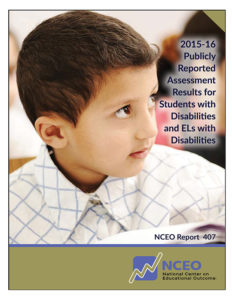 The NCEO report, 2015-16 Publicly Reported Assessment Results for Students with Disabilities and ELs with Disabilities, is the 19th report by the National Center on Educational Outcomes (NCEO) describing how states publicly report online assessment data for students with disabilities in K-12 schools in the United States. The purpose of this report is to examine the extent to which states reported 2015-16 assessment data for students with disabilities “to the public with the same frequency and in the same detail as it reports on the assessment of nondisabled children,” as required by the Individuals with Disabilities Education Act (IDEA). It also describes how states report assessment participation and performance data to the public online. It summarizes these data for grades 4 and 8, and high school, with additional analyses that focus on average performance gaps across years. The report also summarizes the extent to which states report participation and performance for English Learners (ELs) with disabilities and examines public reporting of accommodations.
The NCEO report, 2015-16 Publicly Reported Assessment Results for Students with Disabilities and ELs with Disabilities, is the 19th report by the National Center on Educational Outcomes (NCEO) describing how states publicly report online assessment data for students with disabilities in K-12 schools in the United States. The purpose of this report is to examine the extent to which states reported 2015-16 assessment data for students with disabilities “to the public with the same frequency and in the same detail as it reports on the assessment of nondisabled children,” as required by the Individuals with Disabilities Education Act (IDEA). It also describes how states report assessment participation and performance data to the public online. It summarizes these data for grades 4 and 8, and high school, with additional analyses that focus on average performance gaps across years. The report also summarizes the extent to which states report participation and performance for English Learners (ELs) with disabilities and examines public reporting of accommodations.
Some key highlights of the report include:
- More than half of regular and unique states reported both participation and performance of students with disabilities for all general assessments used for Title 1 accountability
- Approximately two-thirds of regular and unique states reported both participation and performance of students with disabilities taking the alternate assessment based on alternate achievement standards (AA-AAS)
- The number of states reporting participation and performance of ELs with disabilities decreased from the 2014-15
- States were more likely to report the participation and performance of ELs with disabilities taking the AA-AAS compared to the regular assessment
- On reading and math assessments states are reporting a continuing achievement gap between students with and without IEPs
- The size of the achievement gap between students with and without IEPs appears to be smaller at elementary school compared to secondary school
- The size of the average gap for secondary school mathematics appears to be decreasing over time but the reason for the observed change is unclear
Available at https://nceo.umn.edu/docs/OnlinePubs/NCEOReport407.pdf.
